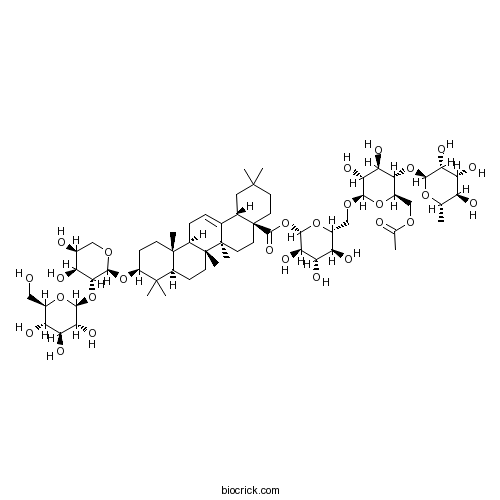Acanthopanaxoside BCAS# 915792-03-9 |

Quality Control & MSDS
3D structure
Package In Stock
Number of papers citing our products

| Cas No. | 915792-03-9 | SDF | Download SDF |
| PubChem ID | 11993928 | Appearance | Powder |
| Formula | C61H98O27 | M.Wt | 1263.43 |
| Type of Compound | Triterpenoids | Storage | Desiccate at -20°C |
| Solubility | Soluble in Chloroform,Dichloromethane,Ethyl Acetate,DMSO,Acetone,etc. | ||
| Chemical Name | [(2S,3R,4S,5S,6R)-6-[[(2R,3R,4R,5S,6R)-6-(acetyloxymethyl)-3,4-dihydroxy-5-[(2S,3R,4R,5R,6S)-3,4,5-trihydroxy-6-methyloxan-2-yl]oxyoxan-2-yl]oxymethyl]-3,4,5-trihydroxyoxan-2-yl] (4aS,6aR,6aS,6bR,8aR,10S,12aR,14bS)-10-[(2S,3R,4S,5S)-4,5-dihydroxy-3-[(2S,3R,4S,5S,6R)-3,4,5-trihydroxy-6-(hydroxymethyl)oxan-2-yl]oxyoxan-2-yl]oxy-2,2,6a,6b,9,9,12a-heptamethyl-1,3,4,5,6,6a,7,8,8a,10,11,12,13,14b-tetradecahydropicene-4a-carboxylate | ||
| SMILES | CC1C(C(C(C(O1)OC2C(OC(C(C2O)O)OCC3C(C(C(C(O3)OC(=O)C45CCC(CC4C6=CCC7C8(CCC(C(C8CCC7(C6(CC5)C)C)(C)C)OC9C(C(C(CO9)O)O)OC1C(C(C(C(O1)CO)O)O)O)C)(C)C)O)O)O)COC(=O)C)O)O)O | ||
| Standard InChIKey | NYFPVHPLEGGWHZ-DIUPZIBKSA-N | ||
| Standard InChI | InChI=1S/C61H98O27/c1-25-36(65)40(69)44(73)51(81-25)86-48-32(24-78-26(2)63)84-50(47(76)43(48)72)80-23-31-39(68)42(71)46(75)53(83-31)88-55(77)61-18-16-56(3,4)20-28(61)27-10-11-34-58(7)14-13-35(57(5,6)33(58)12-15-60(34,9)59(27,8)17-19-61)85-54-49(37(66)29(64)22-79-54)87-52-45(74)41(70)38(67)30(21-62)82-52/h10,25,28-54,62,64-76H,11-24H2,1-9H3/t25-,28-,29-,30+,31+,32+,33-,34+,35-,36-,37-,38+,39+,40+,41-,42-,43+,44+,45+,46+,47+,48+,49+,50+,51-,52-,53-,54-,58-,59+,60+,61-/m0/s1 | ||
| General tips | For obtaining a higher solubility , please warm the tube at 37 ℃ and shake it in the ultrasonic bath for a while.Stock solution can be stored below -20℃ for several months. We recommend that you prepare and use the solution on the same day. However, if the test schedule requires, the stock solutions can be prepared in advance, and the stock solution must be sealed and stored below -20℃. In general, the stock solution can be kept for several months. Before use, we recommend that you leave the vial at room temperature for at least an hour before opening it. |
||
| About Packaging | 1. The packaging of the product may be reversed during transportation, cause the high purity compounds to adhere to the neck or cap of the vial.Take the vail out of its packaging and shake gently until the compounds fall to the bottom of the vial. 2. For liquid products, please centrifuge at 500xg to gather the liquid to the bottom of the vial. 3. Try to avoid loss or contamination during the experiment. |
||
| Shipping Condition | Packaging according to customer requirements(5mg, 10mg, 20mg and more). Ship via FedEx, DHL, UPS, EMS or other couriers with RT, or blue ice upon request. | ||
| Structure Identification | J Nat Prod. 2006 Nov;69(11):1577-81.Biologically active triterpenoid saponins from Acanthopanax senticosus.[Pubmed: 17125224 ]
|

Acanthopanaxoside B Dilution Calculator

Acanthopanaxoside B Molarity Calculator
| 1 mg | 5 mg | 10 mg | 20 mg | 25 mg | |
| 1 mM | 0.7915 mL | 3.9575 mL | 7.915 mL | 15.8299 mL | 19.7874 mL |
| 5 mM | 0.1583 mL | 0.7915 mL | 1.583 mL | 3.166 mL | 3.9575 mL |
| 10 mM | 0.0791 mL | 0.3957 mL | 0.7915 mL | 1.583 mL | 1.9787 mL |
| 50 mM | 0.0158 mL | 0.0791 mL | 0.1583 mL | 0.3166 mL | 0.3957 mL |
| 100 mM | 0.0079 mL | 0.0396 mL | 0.0791 mL | 0.1583 mL | 0.1979 mL |
| * Note: If you are in the process of experiment, it's necessary to make the dilution ratios of the samples. The dilution data above is only for reference. Normally, it's can get a better solubility within lower of Concentrations. | |||||

Calcutta University

University of Minnesota

University of Maryland School of Medicine

University of Illinois at Chicago

The Ohio State University

University of Zurich

Harvard University

Colorado State University

Auburn University

Yale University

Worcester Polytechnic Institute

Washington State University

Stanford University

University of Leipzig

Universidade da Beira Interior

The Institute of Cancer Research

Heidelberg University

University of Amsterdam

University of Auckland

TsingHua University

The University of Michigan

Miami University

DRURY University

Jilin University

Fudan University

Wuhan University

Sun Yat-sen University

Universite de Paris

Deemed University

Auckland University

The University of Tokyo

Korea University
- Glabrolide
Catalog No.:BCN8560
CAS No.:10401-33-9
- Anemarrhenasaponin I
Catalog No.:BCN8559
CAS No.:163047-21-0
- Dihydropalmatine
Catalog No.:BCN8558
CAS No.:26067-60-7
- Rupestonic acid
Catalog No.:BCN8557
CAS No.:115473-63-7
- Uvarigranol B
Catalog No.:BCN8556
CAS No.:164204-79-9
- Ginsenoside Ra2
Catalog No.:BCN8555
CAS No.:83459-42-1
- Panasenoside
Catalog No.:BCN8554
CAS No.:31512-06-8
- Trans sodium crocetinate
Catalog No.:BCN8553
CAS No.:591230-99-8
- Ilexsaponin B2
Catalog No.:BCN8552
CAS No.:108906-69-0
- 28-Demethyl-beta-amyrone
Catalog No.:BCN8551
CAS No.:73493-60-4
- Vinaginsenoside R3
Catalog No.:BCN8550
CAS No.:156012-92-9
- Cistanoside F
Catalog No.:BCN8549
CAS No.:97411-47-7
- Erigoster B
Catalog No.:BCN8562
CAS No.:849777-61-3
- 3'-Demethylnobiletin
Catalog No.:BCN8563
CAS No.:112448-39-2
- Lancifodilactone F
Catalog No.:BCN8564
CAS No.:850878-47-6
- Periplocoside N
Catalog No.:BCN8565
CAS No.:39946-41-3
- 3-Feruloyl-1-Sinapoyl sucrose
Catalog No.:BCN8566
CAS No.:98942-06-4
- Vinaginsenoside R8
Catalog No.:BCN8567
CAS No.:156042-22-7
- Saikogenin D
Catalog No.:BCN8568
CAS No.:5573-16-0
- Gancaonin N
Catalog No.:BCN8569
CAS No.:129145-52-4
- Graveobioside A
Catalog No.:BCN8570
CAS No.:506410-53-3
- 2-Amino-3-carboxy-1,4-naphthoquinone
Catalog No.:BCN8571
CAS No.:173043-38-4
- 4'-O-Methylochnaflavone
Catalog No.:BCN8572
CAS No.:49619-87-6
- Perisesaccharide B
Catalog No.:BCN8573
CAS No.:1095261-93-0
Biologically active triterpenoid saponins from Acanthopanax senticosus.[Pubmed:17125224]
J Nat Prod. 2006 Nov;69(11):1577-81.
Three new triterpenoid saponins, acanthopanaxosides A (1), B (7), and C (13), were isolated from the leaves of Acanthopanax senticosus, together with 12 known saponins. The structures of these new saponins were established as 3-O-beta-D-glucopyranosyl-(1-->2)-alpha-L-arabinopyranosyl-30-nor-olean-12,20(29) -dien-28-oic acid 28-O-alpha-L-rhamnopyranosyl-(1-->4)-6-O-acetyl-beta-D-glucopyranosyl-(1-->6)-bet a-D-glucopyranosyl ester (1), 3-O-beta-D-glucopyranosyl-(1-->2)-alpha-L-arabinopyranosyl oleanolic acid 28-O-alpha-L-rhamnopyranosyl-(1-->4)-6-O-acetyl-beta-D-glucopyranosyl-(1-->6)-bet a-D-glucopyranosyl ester (7), and 3-O-alpha-L-rhamnopyranosyl-(1-->2)-alpha-L-arabinopyranosyl-3beta-hydroxyolean-1 2-ene-28,29-dioic acid (13), on the basis of spectroscopic analysis and chemical degradation. Among the known compounds, sessiloside and tauroside H1 are reported for the first time from A. senticosus. The biological activity of compounds 1-15 was examined against pancreatic lipase. Ciwujianoside C1 (6), tauroside H1 (11), 3-O-alpha-rhamnopyranosyl-(1-->2)-alpha-arabinopyranosyl mesembryanthemoidigenic acid (12), acanthopanaxoside C (13), sessiloside (14), and chiisanoside (15) inhibited pancreatic lipase activity in vitro. In turn, ciwujianosides C2 (3), D2 (5), C4 (8), and C3 (10) and hederasaponin B (9) enhanced this enzyme.


